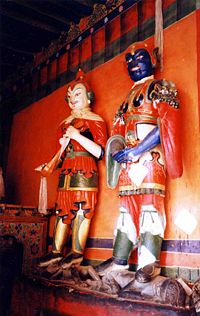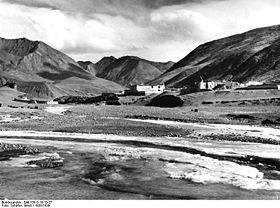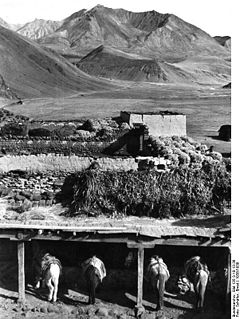
Ralung Monastery
Encyclopedia

Ü-Tsang
Ü-Tsang , or Tsang-Ü, is one of the three traditional provinces of Tibet, the other two being Amdo and Kham. Geographically Ü-Tsang covered the central and western portions of the Tibetan cultural area, including the Tsang-po watershed, the western districts surrounding and extending past Mount...
region of western Tibet
Tibet
Tibet is a plateau region in Asia, north-east of the Himalayas. It is the traditional homeland of the Tibetan people as well as some other ethnic groups such as Monpas, Qiang, and Lhobas, and is now also inhabited by considerable numbers of Han and Hui people...
, south of the Karo La (pass), is the traditional seat of the Drukpa order of Tibetan Buddhism
Tibetan Buddhism
Tibetan Buddhism is the body of Buddhist religious doctrine and institutions characteristic of Tibet and certain regions of the Himalayas, including northern Nepal, Bhutan, and India . It is the state religion of Bhutan...
. It was founded in 1180 by Tsangpa Gyare
Tsangpa Gyare
The great ascetic Drogon Tsangpa Gyare was the main disciple of Lingchen Repa Pema Dorj and the founder of the Drukpa Lineage of Tibetan Buddhism the main or central branch of which was, until the 17th Century, transmitted by his hereditary family lineage at Ralung in the Tsang region of western...
who was the First Gyalwang Drukpa
Gyalwang Drukpa
The Gyalwang Drukpa or Drukchen are a line of re-incarnate lamas or tulku who are the head of the Drukpa school, one of the independent Sarma schools of Tibetan Buddhism...
, a disciple of Drogon Pakmodrupa, and the founder of the Drukpa order.
Location


Gyantse
Gyantse is a town located in Gyangzê County, Shigatse Prefecture. It was historically considered the third largest and most prominent town in the Tibet region , but there are now at least ten larger Tibetan cities.-Location:The town is strategically located in the Nyang River Valley on the ancient...
county several kilometers south of the road connecting Nakartse and Lungmar
Lungmar
-See also:*List of towns and villages in Tibet...
, immediately north of the Gasa district
Gasa District
Gasa District or Gasa Dzongkhag is one of the 20 dzongkhags comprising Bhutan. Its capital is Gasa Dzong near Gasa. It is located in the far north of the county and spans the Middle and High Himalayas. The dominant language of the district is Dzongkha, the national language...
of Bhutan
Bhutan
Bhutan , officially the Kingdom of Bhutan, is a landlocked state in South Asia, located at the eastern end of the Himalayas and bordered to the south, east and west by the Republic of India and to the north by the People's Republic of China...
. In previous times, trade could be conducted across the Yak La pass across the high Himalayas
Himalayas
The Himalaya Range or Himalaya Mountains Sanskrit: Devanagari: हिमालय, literally "abode of snow"), usually called the Himalayas or Himalaya for short, is a mountain range in Asia, separating the Indian subcontinent from the Tibetan Plateau...
, extending the influence of Ralung to the south.
The monastery is surrounded by the towering peaks and glacier fields of Gyetong Soksum (6,244m), Jangzang Lhamo (6,324m) and Nojin Gangzang (7,191m). From the beginning the location was recognized as especially auspicious:
History
The founder of Bhutan, the first ShabdrungShabdrung
Shabdrung , was a title used when referring to or addressing great lamas in Tibet, particularly those who held a hereditary lineage...
, Ngawang Namgyel, was the 18th Abbott of Ralung monastery. In 1616 he fled Tibet when his recognition as the reincarnation of renowned scholar Pema Karpo
Pema Karpo
Kunkhyen Pema Karpo was the fourth Gyalwang Drukpa, head of the Drukpa lineage of Tibetan Buddhism. He was the most famous and learned of all the Gyalwang Drukpas...
was challenged by the governor of Tsang
Ü-Tsang
Ü-Tsang , or Tsang-Ü, is one of the three traditional provinces of Tibet, the other two being Amdo and Kham. Geographically Ü-Tsang covered the central and western portions of the Tibetan cultural area, including the Tsang-po watershed, the western districts surrounding and extending past Mount...
province. Ngawang Namgyel proved to be a worthy incarnation of Pema Karpo, as he unified the warring valleys of Bhutan, fending off attacks from Tibet, forming a national identity, and establishing a Drukpa dual system of government
Dual system of government
The Dual System of Government or Cho-sid-nyi is the traditional diarchal political system of Tibetan peoples whereby the Desi coexists with the spiritual authority of the realm, usually unified under a third single ruler. The actual distribution of power between institutions varied over time and...
that continues to this day in modified form as the Royal Government of Bhutan.
Other names for Ralung monastery include Shedrub Chokhar Ling Gompa (the original name), Druk Ralung, and Ralung Gompa.
Early Drukpa lineage of Ralung
Chart of the hereditary Palden Drukpa lineage (དཔལ་ལྡན་འབྲུག་པའི་གདུང་བརྒྱུད་) of Ralung from the founder Tsangpa GyareTsangpa Gyare
The great ascetic Drogon Tsangpa Gyare was the main disciple of Lingchen Repa Pema Dorj and the founder of the Drukpa Lineage of Tibetan Buddhism the main or central branch of which was, until the 17th Century, transmitted by his hereditary family lineage at Ralung in the Tsang region of western...
(12C.) to the last hereditary throne holder, Shabdrung Ngawang Namgyal (17C.), who moved to Bhutan where he unified the country and established the Southern Drukpa school. Successive throne holders are numbered with their names in bold text.
External links
- Ralung Monastery
- rwa lung TBRC G44
- Ralung

